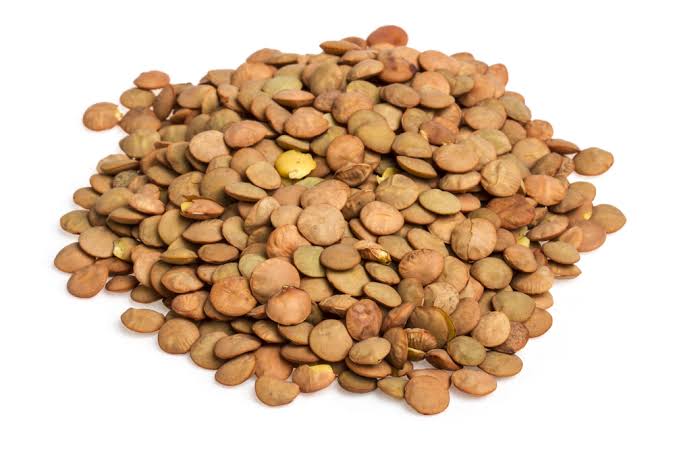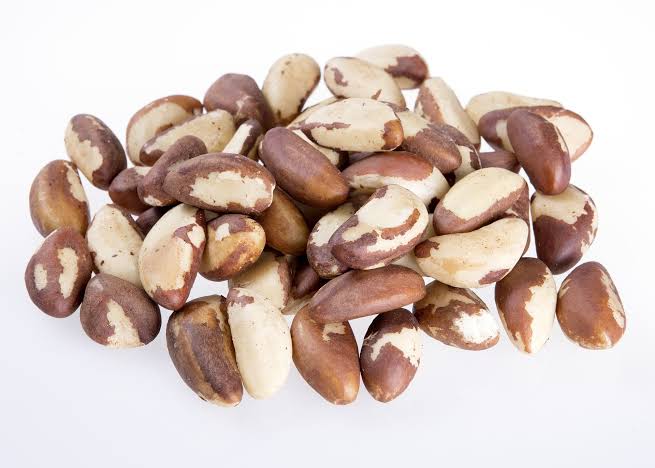Lentils belong to the legume family. They have the appearance of a small bean, grow in pods, and come in red, brown, black, and green colours. They still have a lot of protein and fibre in them.
Lentils are a convenient and fast source of high-quality protein for many people around the world due to their low cost and ease of preparation.
In this post, we’ll look at how lentils can improve your health, as well as their nutritional value and how to integrate them into a healthy diet.
Types
In the United States, there are three major types of lentils. These include:
- Brown lentils: These have a mild, earthy flavour and keep their shape well, but if overcooked, they will become mushy. These are delicious in soups and as a side dish. They come in a variety of colours, from light brown to black.
- French green, or Puy, lentils: These have a peppery flavour and a crunchy texture, making them a satisfying salad choice.
- Red lentils: These are brown Massor lentils that have had their hulls removed and are popular in Middle Eastern and Indian cuisine.
Black Beluga lentils, which resemble caviar and are more costly, are another choice. White lentils, which are black lentils without the hull, and Macachiados lentils, which have a solid, nutty flavour and are frequently used in Mexican dishes, are two types of lentils.
Nutritional value
Lentils are a nutrient-dense food. Minerals, protein, and fibre abound in them.
100 grams (g) of cooked lentils contains:
- 116 calories (kcal)
- 9.02 g of protein
- 0.38 g of fat
- 20.13 g of carbohydrates, including 7.9 g of fiber and 1.8 g of sugar
Lentils also provide the following essential nutrients:
- folate
- iron
- manganese
- phosphorus
- thiamin
- potassium
- vitamin B-6
Lentils are also a source of:
- riboflavin
- niacin
- pantothenic acid
- magnesium
- zinc
- copper
- selenium
Health benefits

The consumption of all types of plant-based foods has been linked to a lower risk of a variety of lifestyle-related health conditions.
People who consume more healthful plant foods have a lower risk of dying from cardiovascular disease and all causes, according to a 2019 report published in the Journal of the American Heart Association.
Plant-based foods are high in fibre, vitamins, and minerals, and they may also have antioxidant properties. Antioxidants combat free radicals, which are cellular molecules that can cause inflammation and cancer.
Heart health
Fiber, folic acid, and potassium are all abundant in lentils. All of these nutrients are beneficial to heart health.
Increased fibre consumption, according to the American Heart Association (AHA), may lower levels of low density lipoprotein (LDL) cholesterol, or bad cholesterol.
Fiber may not only reduce the risk of cardiovascular disease, but it may also delay the progression of the disease in high-risk individuals.
Lentils are a good source of vitamins, minerals, and fibre. They’re also high in protein and can be used as a meat substitute.
When meat is replaced in the diet with a high fibre food like lentils, the risk of heart disease is reduced.
Lentils’ potassium, calcium, and magnesium have been shown in studies to naturally lower blood pressure. The DASH eating plan includes foods that are rich in these minerals. This diet is recommended by the National Heart, Lung, and Blood Institute (NHLBI) for lowering blood pressure.
Lentils, according to the National Institutes of Health (NIH), are one of the best potassium-rich foods.
Find out more about the DASH diet.
Pregnancy
Lentils provide a large amount of folate.
Folate is important in the prevention of neural tube defects in newborns.
This important nutrient can also help to lower the risk of gestational diabetes. According to a 2019 study of 14,553 pregnant women, those who consumed more folate during pregnancy had a lower risk of developing gestational diabetes.
Females of childbearing age should eat at least 400 micrograms (mcg) of folate or folic acid per day, according to the Centers for Disease Control and Prevention (CDC). Women can increase their consumption during pregnancy and breastfeeding, according to the CDC.
Cancer
Lentils also provide selenium.
Selenium has been shown to slow tumour development. By stimulating the development of T cells, it can also enhance a person’s immune response to infection. T cells are disease killers.
According to the National Institutes of Health, selenium may aid in the prevention of colorectal, prostate, lung, bladder, skin, esophageal, and gastric cancers.
However, further research into the cancer-prevention benefits of selenium is required, as studies on the mineral have yielded mixed results so far.
Fiber can also be linked to a lower risk of colorectal cancer, according to A meta-analysis of 405 articles published in 2019.
Fighting fatigue
Fatigue is often caused by an iron deficiency. The body’s ability to use energy effectively may be harmed by a lack of iron in the diet. Heme and nonheme are the two forms of iron.
Nonheme iron is found in plants, and lentils are an especially good source.
Meat and fish provide heme iron
Nonheme iron is a necessary source of iron for people who don’t eat meat for health reasons or other reasons. Nonheme iron, on the other hand, does not absorb as well as heme iron. As a result, consider mixing it with vitamin C-rich foods like oranges, berries, and peppers to boost absorption.
Digestion, regularity, and satiety
By acting as a “bulking agent” in the digestive system, adequate fibre intake is a significant factor in weight loss.
Fiber in the diet helps to increase the feeling of fullness and decrease appetite. This can help a person consume less calories overall.
Lentils’ high fibre content also helps to keep the digestive tract safe, preventing constipation and encouraging daily bowel movements.
Diet plan
Brown, green, and red lentils can be used in a variety of ways in the diet.
- Brown lentils are the most affordable and soften the fastest when cooked. Soups and stews are the best places to use them.
- Green lentils have a nuttier flavour than red lentils. When cooked, they retain their firmness and make excellent salad or taco toppings.
- The flavour of red lentils is milder. They’re great for bulking up Indian dals and purees, and when cooked, they’re also soft.
Lentils, unlike dried beans, do not need to be soaked. Any dirt on the lentils should be rinsed away, and any damaged lentils or foreign material should be discarded.
Quick tips:
People can incorporate lentils into their diet in a variety of ways that are both simple and delicious:
- Lentils can be added to any soup or stew recipe for added nutrition and fibre.
- For a quick protein source, cook lentils ahead of time and store them in the refrigerator.
- Lentils can be used in place of beans in any recipe.
- Red lentils can be used in place of half of the meat in a Bolognese sauce or lasagna.
- By mashing cooked lentils with a fork and adding garlic, onion, chilli powder, and chopped tomatoes, you can make a lentil dip.
- Look for new snacks and foods made with lentils, such as lentil crackers or chips, as well as lentil pasta.
Risk factors
Constipation and flatulence can occur when you consume a lot of fibre.
Anyone who wants to increase their fibre intake should do the following:
- To avoid constipation, drink plenty of water.
- gradually increase their fibre intake over 1–2 months
- consuming small quantities of fibre at each meal.
As the body responds to the increased fibre, these tips may help prevent digestive discomfort.
Irritable bowel syndrome (IBS) sufferers may experience digestive symptoms due to the presence of fermentable carbohydrates (FODMAPs) in lentils . People with IBS usually tolerate canned lentils because they are low in FODMAPs.
Sources
- Folate. (2019).
https://ods.od.nih.gov/factsheets/Folate-Consumer/ - What are the benefits of lentils? https://www.medicalnewstoday.com/articles/297638
- Folic acid. (2018).
https://www.cdc.gov/ncbddd/folicacid/about.html - Hervik, A. K., & Svihus, B. (2019). The role of fiber in energy balance.
https://www.ncbi.nlm.nih.gov/pmc/articles/PMC6360548/ - Iron. Fact sheet for health professionals. (2019).
https://ods.od.nih.gov/factsheets/Iron-HealthProfessional/ - Kim, H., et al. (2019). Plant-based diets are associated with a lower risk of incident cardiovascular disease, cardiovascular disease mortality, and all-cause mortality in a general population of middle-aged adults [Abstract].
https://www.ncbi.nlm.nih.gov/pubmed/31387433 - Lentils, mature seeds, cooked, boiled, without salt. (2019).
https://fdc.nal.usda.gov/fdc-app.html#/food-details/172421/nutrients - Li, M., et al. (2019). Prepregnancy habitual intakes of total, supplemental, and food folate and risk of gestational diabetes mellitus: A prospective cohort study [Abstract].
https://care.diabetesjournals.org/content/42/6/1034 - Masrul, M., & Nindrea, R. D. (2019). Dietary fibre protective against colorectal cancer patients in Asia: A meta-analysis.
https://www.ncbi.nlm.nih.gov/pmc/articles/PMC6560290/ - Potassium. Fact sheet for health professionals. (2019).
https://ods.od.nih.gov/factsheets/Potassium-HealthProfessional/ - Ryan, M. (2018). Going meatless once a week.
http://www.eatright.org/resource/food/nutrition/vegetarian-and-special-diets/going-meatless - Selenium. Fact sheet for health professionals. (2019).
https://ods.od.nih.gov/factsheets/Selenium-HealthProfessional/ - Whole grains, Refined grains, and dietary fiber. (2016).
http://www.heart.org/HEARTORG/HealthyLiving/HealthyEating/HealthyDietGoals/Whole-Grains-and-Fiber_UCM_303249_Article.jsp%20- .V34R6eYrJTY - Your guide to lowering your blood pressure with DASH. (2006).
https://www.nhlbi.nih.gov/files/docs/public/heart/new_dash.pdf






